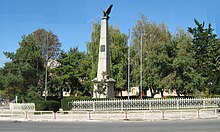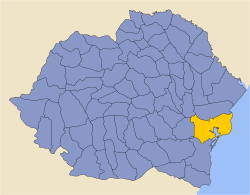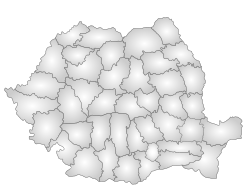Tulcea County
Tulcea County
Județul Tulcea | |
|---|---|
 | |
| Coordinates: 44°59′N 28°46′E / 44.98°N 28.77°E | |
| Country | Romania |
| Development region | Sud-Est |
| Historical region | Dobruja |
| Capital | Tulcea |
| Government | |
| • President of the County Board | Horia Teodorescu (PSD) |
| • Prefect | Alexandru Dan Munteanu |
| Area | |
• Total | 8,484 km2 (3,276 sq mi) |
| • Rank | 4th |
| Population (2021-12-01)[1] | |
• Total | 193,355 |
| • Rank | 40th |
| • Density | 23/km2 (59/sq mi) |
| Telephone code | (+40) 240 or (+40) 340[2] |
| ISO 3166 code | RO-TL |
| GDP (nominal) | US$ 1.378 billion (2015) |
| GDP per capita | US$ 6,838 (2015) |
| Website | County Council County Prefecture |

Tulcea County (Romanian pronunciation: [ˈtult͡ʃe̯a]) is a county (județ) of Romania, in the historical region Dobruja, with the capital city at Tulcea. It includes in its northeast corner the large and thinly-populated estuary of the Danube.
Demographics
[edit]In 2021, Tulcea County had a population of 193,355. The population density was 22.8/km2, the lowest among the counties of Romania, due to the inclusion within the area of the lowly-populated Danube estuarial wetlands.
- Romanians - 79.18%[3]
- Lipovans - 4.14%
- Roma - 2.05%
- Turks - 0.51%
- Ukrainians - 0.47%
- Greeks - 0.14%
- Tatars - 0.05%
- Bulgarians - 0.02%
In the Danube Delta there is an important community of Russians and Lipovans. In the south of the county there are communities of Turks. The region once was a centre of Islam in Romania.
| Year | County population[4] |
|---|---|
| 1948 | 192,228 |
| 1956 | 223,719 |
| 1966 | 236,709 |
| 1977 | 254,531 |
| 1992 | 270,197 |
| 2002 | 256,492 |
| 2011 | 201,462 |
| 2021 | 193,355 |
| Ethnicity | 2002[5] | 2011[6] | 2021[6] |
|---|---|---|---|
| Total | 256,492 | 213,083 | 193,355 |
| Romanian | 230,843 (90%) | 180,496 (84.71%) | 153,094 (79.18%) |
| Lipovan | 16,350 (6.4%) | 10,342 (4.85%) | 8,010 (4.14%) |
| Roma | 2,272 (0.88%) | 3,423 (1.61%) | 3,963 (2.05%) |
| Turks | 3,334 (1.3%) | 1,674 (0.78%) | 993 (0.51%) |
| Ukrainian | 1,279 (0.5%) | 1,083 (0.51%) | 900 (0.47%) |
| Greek | 1,680 (0.64%) | 1,181 (0.55%) | 266 (0.14%) |
| Tatar | 179 (0.07%) | 119 (0.06%) | 106 (0.05%) |
| Bulgarian | 61 (0.02%) | 23 (0.01%) | 34 (0.02%) |
| Others | 494 (0.19%) | 14,742 (6.92%) | 25,989 (13.44%) |
Geography
[edit]The county has a total area of 8,484 km2 (3,276 sq mi).


The most significant feature of Tulcea County is the Danube Delta, which occupies about 1/3 of the entire surface and is located in the North-East side of the county. The Delta has three main branches: the Sulina branch (the only one navigable by large ships) in the middle, the Chilia branch in the North (the border with Ukraine) and the Sfântu Gheorghe branch (Saint George) in the South.
In the South-East of the county there are two lagoons: Razelm Lake and Sinoe Lake. In the Danube Delta and in the South—in the area between the Sfântu Gheorghe Channel and Razelm Lake—there are countless channels and small lakes. The entire area is included in the UNESCO list of World Heritage Sites and Biosphere reserves.
The Danube River flows around the county in the West and North side. In the West, there is the Măcin Branch which flows on the East side of the Great Brăila Island. From Smârdan (on the opposite side from Brăila) to Pătlăgeanca (close to Tulcea), the Danube has only one big flow of water, around which there are an immense number of lakes and small channels.
In the center of the county, there is the Casincea Plateau and the Măcin Mountains—the remains of a prehistorical mountains range (more than 400 million years old), with the greatest height at about 400 m.
Neighbours
[edit]- Black Sea in the East.
- Brăila County in the West.
- Galați County in the North-West
- Ukraine in the North - the Odesa Oblast.
- Constanța County in the South.
Economy
[edit]Agriculture and fishing are the main occupations, involving about 48% of the population. Industry is concentrated in the large towns only.
The predominant industries in the county are:
- Food industry.
- Textile industry.
- Ship building industry.
- Metallurgy - aluminium.
- Chemical industry.
- Construction materials.
Tourism
[edit]Tourism is an important activity in the county, the Danube Delta being one of the most visited areas in Romania.
The main destinations for tourists are:
- The Danube Delta
- The town of Sulina—the last town on the Danube.
- The areas around Sfântu Gheorghe, Mahmudia, Crișan, Caraorman, Chilia Veche.
- The city of Tulcea.
- The Roman fort of Halmyris.
Politics
[edit]The Tulcea County Council, renewed at the 2020 local elections, consists of 30 counsellors, with the following party composition:[7]
| Party | Seats | Current County Council | |||||||||||||
|---|---|---|---|---|---|---|---|---|---|---|---|---|---|---|---|
| National Liberal Party (PNL) | 13 | ||||||||||||||
| Social Democratic Party (PSD) | 12 | ||||||||||||||
| PRO Romania (PRO) | 3 | ||||||||||||||
| People's Movement Party (PMP) | 2 | ||||||||||||||
Administrative divisions
[edit]


Tulcea County has 1 municipality, 4 towns and 46 communes.
- Municipalities
- Tulcea - capital city; population: 73,707 (as of 2011)
- Towns
- Communes
- Baia
- Baidaud
- Beștepe
- C. A. Rosetti
- Carcaliu
- Casimcea
- Ceamurlia de Jos
- Ceatalchioi
- Cerna
- Chilia Veche
- Ciucurova
- Crișan
- Dăeni
- Dorobanțu
- Frecăței
- Greci
- Grindu
- Hamcearca
- Horia
- I. C. Brătianu (Zaclău, 23 August)
- Izvoarele
- Jijila
- Jurilovca (Unirea)
- Luncavița
- Mahmudia
- Maliuc
- Mihai Bravu
- Mihai Kogălniceanu
- Murighiol (Independența)
- Nalbant
- Niculițel
- Nufăru
- Ostrov
- Pardina (1 Mai)
- Peceneaga
- Sarichioi
- Sfântu Gheorghe
- Slava Cercheză
- Smărdan
- Somova
- Stejaru
- Topolog
- Turcoaia
- Valea Nucarilor
- Valea Teilor
- Văcăreni
Historical county
[edit]Județul Tulcea | |
|---|---|
County (Județ) | |
 The Tulcea prefecture building from the interwar period, now the Tulcea Art Museum. | |
 | |
| Country | |
| Historic region | Dobrogea |
| Capital city (Reședință de județ) | Tulcea |
| Area | |
• Total | 8,628 km2 (3,331 sq mi) |
| Population (1930) | |
• Total | 184,038 |
| • Density | 21/km2 (55/sq mi) |
| Time zone | UTC+2 (EET) |
| • Summer (DST) | UTC+3 (EEST) |
Historically, the county was located in the southeastern part of Greater Romania, in the region of north Dobruja. The borders of the historic county coincide with those of the present county. It bordered on the west with Brăila County, northwest with Covurlui County, to the north with Ismail County, to the south by Constanța County, and to the east and south-east with the Black Sea.
Administration
[edit]
The county was originally divided administratively into four districts (plăși):[8]
- Plasa Babadag, headquartered at Babadag
- Plasa Gurile Dunării, headquartered at Tulcea
- Plasa Măcin, headquartered at Măcin
- Plasa Topolog, headquartered at Topolog
As in the present day there were five towns (cities): Tulcea (county headquarters), Babadag, Măcin, Isaccea and Sulina.
Population
[edit]
According to the 1930 census data, the county population was 184,038 inhabitants, ethnically divided as follows: 62.6% Romanians, 12.2% Russians, 10.6% Bulgarians, 2.5% Turks, 1.7% Greeks, 1.3% Germans, as well as other minorities.[9] From the religious point of view, the population was 85.8% Eastern Orthodox, 8.3% Old-Rite Lipovan Orthodox, 2.8% Muslim, 1.5% Roman Catholic, 0.6% Lutheran, as well as other minorities.
Urban population
[edit]In 1930, the county's urban population was 41,632 inhabitants, comprising 64.7% Romanians, 12.8% Russians, 5.5% Turks, 4.4% Greeks, 3.3% Bulgarians, 2.5% Jews, 0.8% Germans, as well as other minorities. Mother tongues among the urban population were Romanian (69.4%), followed by Russian (15.0%), Turkish (5.5%), Greek (3.9%), Yiddish (1.5%), as well as other minorities.[9] From the religious point of view, the urban population was composed of 87.5% Eastern Orthodox, 5.7% Muslim, 2.6% Jewish, 1.9% Roman Catholic, as well as other minorities.
References
[edit]- ^ "Populaţia rezidentă după grupa de vârstă, pe județe și municipii, orașe, comune, la 1 decembrie 2021" (XLS). National Institute of Statistics.
- ^ The number used depends on the numbering system employed by the phone companies on the market.
- ^ National Institute of Statistics, [1]}}
- ^ National Institute of Statistics, "Populația la recensămintele din anii 1948, 1956, 1966, 1977, 1992 și 2002"
- ^ National Institute of Statistics, 2002 census: Ethnic structure per county
- ^ a b "Ethnic population at the censuses in the period 1930–2021" (in Romanian). INSSE. Retrieved 24 April 2024.
- ^ "Rezultatele finale ale alegerilor locale din 2020" (Json) (in Romanian). Autoritatea Electorală Permanentă. Retrieved 2020-11-02.
- ^ Portretul României Interbelice - Județul Tulcea
- ^ a b Recensământul general al populației României din 29 decemvrie 1930, Vol. II, pag. 480
External links
[edit]Lua error in Module:Navbox at line 535: attempt to get length of local 'arg' (a number value). Lua error in Module:Navbox at line 535: attempt to get length of local 'arg' (a number value).
- Tulcea County
- Counties of Romania
- 1879 establishments in Romania
- 1938 disestablishments in Romania
- 1940 establishments in Romania
- 1950 disestablishments in Romania
- 1968 establishments in Romania
- States and territories established in 1879
- States and territories disestablished in 1938
- States and territories established in 1940
- States and territories disestablished in 1950
- States and territories established in 1968



